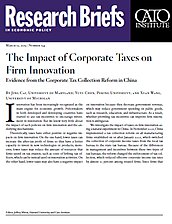Innovation has been increasingly recognized as the main engine for economic growth. Policymakers in both developed and developing countries have started to use tax incentives to encourage investment in innovation. But we know very little about the impact of such policies on firm innovation and the underlying mechanisms.
Theoretically, taxes have either positive or negative impacts on firm innovation. On the one hand, lower taxes can increase the after-tax profit of firms so they have a better capacity to invest in new technologies or products; moreover, lower taxes may reduce the amount of resources that firms spend on tax evasion, such as costs of bribing tax officers, which can be instead used on innovation activities. On the other hand, lower taxes may also have a negative impact on innovation because they decrease government revenue, which may reduce government spending on public goods, such as research, education, and infrastructure. As a result, whether providing tax incentives can improve firm innovation is ambiguous.
We investigate the impact of taxes on firm innovation using a natural experiment in China. In November 2001, China implemented a tax collection reform on all manufacturing firms established on or after January 2002, which switched the collection of corporate income taxes from the local tax bureau to the state tax bureau. Because of the differences in management and incentives between these two types of tax bureaus, the reform changed the enforcement of tax collection, which reduced effective corporate income tax rates by almost 10 percent among treated firms. Since firms that registered before 2002 were not affected by the reform, the policy change created exogenous variations in the effective tax rate among similar firms established before or after 2002. We can thus use the generated variation in the effective tax rate to identify the impact of taxes on firm innovation.
To test the impact taxes have on innovation, we combine a comprehensive dataset of all medium and large enterprises in China between 1998 and 2007 with patent data from the State Intellectual Property Office (SIPO), including all patents applied in China by the year 2014. We use the data to measure three dimensions of innovation activities: input (research and development [R&D] expenditure and skilled labor ratio), output (number of patent applications), and quality (types and characteristics of patent applications).
The key assumption of the analysis is that firm cohort should have a significant impact on the effective corporate tax rate; however, all other unobserved determinants of firm innovation are not correlated with firm cohort. We provide two pieces of evidence to validate the estimation strategy. First, the reform significantly reduced the effective tax rate: the tax rate is almost 10 percent lower among firms established after 2002 compared with those registered before 2002. Second, there is no significant difference in firm entry around 2002, suggesting that the reform was a surprise to firms and that they did not selectively postpone the registration date.
Our analysis yields several interesting results. First, we show a strong and robust causal relationship between tax rate and firm innovation: decreasing the effective tax rate by one standard deviation increases the average number of patent applications by a significant 5.7 percent. The reform also stimulates R&D expenditures and increases the skilled-labor ratio by 14 percent. Second, the impact of the reform on patenting mainly comes from its effect on invention and utility patents, suggesting that the improvement in innovation outcomes is not merely driven by the low-quality design patents. Third, we provide evidence that suggests a low tax rate can stimulate a firm’s innovation by alleviating financial constraints, which allows a firm to reallocate resources from tax evasion activities.
Furthermore, we study why firm innovation is affected by the tax reform. We test two potential mechanisms: a financial constraint channel and a tax evasion channel. First, we test whether reducing tax cost helps alleviate financial constraint and whether firms use the money they save to carry out innovation activities. Under a neoclassical framework, if R&D expenditure is fully deductible, then the tax rate should not affect innovation because it does not change the aftertax marginal benefit and cost of innovation. However, when the financial market is incomplete or inefficient and a firm mostly relies on its own after-tax profit, a lower effective tax rate could affect innovation investment. We use interest payment as the proxy for degree of financial constraint and provide evidence that suggests a low tax rate stimulates a firm’s innovation by alleviating financial constraints.
Second, in principle a lower effective tax rate could also release resources that firms spend on tax avoidance, which firms can in turn use on innovation. To test this potential channel, we measure the tax evasion activity of firms and find that firms engaged in more tax evasion can release more resources for innovation.
NOTE:
This research brief is based on Jing Cai, Yuyu Chen, and Xuan Wang, “The Impact of Corporate Taxes on Firm Innovation: Evidence from the Corporate Tax Collection Reform in China,” NBER Working Paper no. 25146, October 2018, https://www.nber.org/papers/w25146.
About the Authors

This work is licensed under a Creative Commons Attribution-NonCommercial-ShareAlike 4.0 International License.
